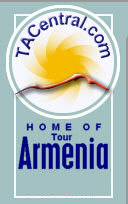Hey Arpi, come here, it's time for supper!" No reply. Karen, the host of the lodgings where we are sitting and conversing, nods his head affirmatively. "It had to be especially so. She never duns for a meal, but waits in her corner. She always keeps a jolting sense of merit", he says. "And we ourselves carry the soup-bowl to Arpi with her favorite "Whiskas."
Arpi is wonderfully pretty she-cat - snow-white, semi-longhaired, and amber-eyed, with a red spot on the head and red rings on the tail. Namely, this is the classical feature of a very ancient and enigmatic breed, which is called as Turkish Vans, or more exactly Armenian Vans. Undisputedly, this breed has deep roots in Armenian history.
The birthplace of Armenian Vans is the region of Lake Van, which is situated in contemporary Eastern Turkey, but before that, was a part of Western Armenia. So, the lake gave them their current name, by which they now are famous worldwide. However odd it is, Armenia itself has begun to recognize Van cats mainly after the collapse of the Soviet Union, when contacts between Armenia and the Diaspora have become significantly more active.
Beautiful Arpi arrived here in 1993. American architect and historian Hrach Nargizian, who now lives in San Francisco, USA, and is Armenian by origin, brought her and a male, Sipan, here. He bought them in San Francisco, and paid $500 for Arpi (depending on pedigree, it can be much higher - up to $ 1,200-1,500). As for Sipan, an American cat-lover, Karen Hooker helped him. Mrs. Hooker has a big nursery of Van cats, named "Pairodox," in New Ellenton, SC, and she is now considered as one of the most authoritative specialists on cats in the world. When she heard that a Van male-cat would be carried to Armenia, she simply gave him as a gift.
Arpi and Sipan came to Armenian biologist Karen Manvelyan (he now heads the Armenian Representative office of the Wild Nature Protection Fund). He prepared himself to breed this unique species in Armenia. Sickly Sipan died in 1997, but succeeded in giving descendants -two nice kitties that were named Van and Sevan. It's noteworthy that they have different eyes: one is blue, and the other is amber-yellow. Because the sometimes so-called recessive gene has its influence, when this gene "awakens," Van cats obtain a peculiar attractiveness.
The Vans' collective portrait was imprinted on a memorial envelope, issued by the Armenian Ministry of Communications in 1999. Postal stamps were also printed at that time.
At one time, Vans get into belles-lettres, as well. Well-known Armenian writer Vrtanes Papazian (1864 - 1920) dedicated one of his novels to them, which was named "Van Cats." In the tale, he described a Van cat whose kittens were murdered by one gray cat. The mother that became an orphan mourned her kitten, but after had another litter. The gray also cat killed these kittens, but the Van cat sought revenge, killing the gray cat. 'This story can be explained as an allegory: Turkey attacks Armenia, committing the massacres, but one day Armenia will rise up again and destroy Turkey," says Nargizian.
There is some evidence that Armenians escaping from the horrors of the Genocide also took their lovely pets - their cats - with them. That was the way that Van cats reached Armenia in Soviet times. However, because of the absence of proper breeding, they have gradually mixed with local shorthaired breeds. Nevertheless, the marks of former aristocracy sometimes can be seen in today's "mongrels": red spots on the head, rings on the tale, and pretty amber eyes...
"Van cats are very big and massive. "Perhaps only the English blue species of cats may touch them by dimensions," Manvelyan says. "Vans' middle-hairiness protects them from heat in the summer and from cold in the winter period. And their pile is not cattish, but rather like a rabbit's. Even the inner parts of the paws are covered by hair, in order not to freeze in the snow in the winter, and to not be burnt by scorching stones in the summer."
It is recognized that the history of the Vans' discovery started in 1955, when British photo-reporters Sonya Halliday and Laura Lushington visited the area surrounding the city of Van. They were highly excited by the beauty of Van cats, and brought some specimens to England to breed. Since those times, not only Great Britain, but also the United States, Germany, the Netherlands, Japan, and even South Africa have become known as centers of such breeding.
Specialists warn that people quite often confuse Vans with Angora cats. Both species are widespread in Turkey, and are very much alike. However, the Van cat is a unique result of natural breeding, realized in time immemorial, without any human interference. And one prominent characteristic: Vans are the only felines that are able to swim, dive, and fish.
Armenians believe that this species is an integral part of their tradition and history. At the same time, Turkey considers it as real national property. Several years ago they even created the Van Research Institute.
"Perhaps a collaborative relationship between the zoo in Armenia and this research institute could produce some mutual beneficial results for humans and kittens too... I know the political realities make that difficult - but perhaps for the sake of the cats it can be do



